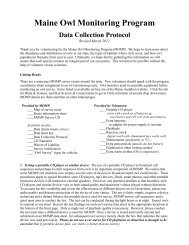Focus Species Forestry - Maine Audubon
Focus Species Forestry - Maine Audubon
Focus Species Forestry - Maine Audubon
Create successful ePaper yourself
Turn your PDF publications into a flip-book with our unique Google optimized e-Paper software.
Habitat Use: The habitat-use chart 3 identifies the specific ecosystems and development stages<br />
that are focus habitats for the species as well as and other habitats that it uses.<br />
<strong>Focus</strong> Habitat: For most species listed, a focus habitat is one that provides the<br />
best overall habitat conditions for the species. For a few, the focus habitat is one<br />
that is used for only part of the year but is essential for the species’ survival.<br />
Examples of the latter include wintering areas for deer in northern <strong>Maine</strong> and<br />
vernal pools that are used seasonally by wood frogs and spotted salamanders.<br />
Where a species focus habitat includes two or more development stages,<br />
attempt to provide at least half of the area in the older development stages.<br />
Small-diameter intermediate stands may provide early successional habitat,<br />
while larger-diameter intermediate stands are likely to provide habitat for<br />
many mature-forest species.<br />
Although all mature forest species will do equally well in late-successional<br />
habitat, late successional is only listed as a focus habitat when it is a required<br />
habitat for a species.<br />
Other Habitat: “Other habitat” is habitat commonly used by a species, but it is<br />
used less frequently or is less critical (e.g. non wintering habitat for deer) than a<br />
focus habitat. The “other habitat” needs of a given species are taken care of by<br />
other focus species. For example, spruce-fir is listed as “other habitat” for pileated<br />
woodpecker. Management for black-backed woodpecker and American marten,<br />
both spruce-fir focus species, will also provide habitat for the pileated<br />
woodpecker in that forest type.<br />
Habitat Use Modifiers: Some species are most likely to be found in certain<br />
forest types only when certain habitat conditions are found.<br />
Mx<br />
U<br />
C<br />
Habitat Use Modifiers<br />
A coniferous component in hardwood forests or<br />
deciduous component in softwood forests is<br />
important<br />
Identifies when a species requires understory<br />
saplings or shrubs<br />
Requires or is strongly associated with snags or<br />
cavity trees<br />
3 The format of the habitat use chart was adapted from charts that first appeared in the U.S. Forest Service<br />
publication New England Wildlife: Habitat, Natural History, and Distribution (DeGraaf and Rudis, 1986). Habitat<br />
uses in this guide represent the author’s synthesis of current literature and input from the advisory committee.<br />
36<br />
<strong>Focus</strong> <strong>Species</strong> <strong>Forestry</strong>


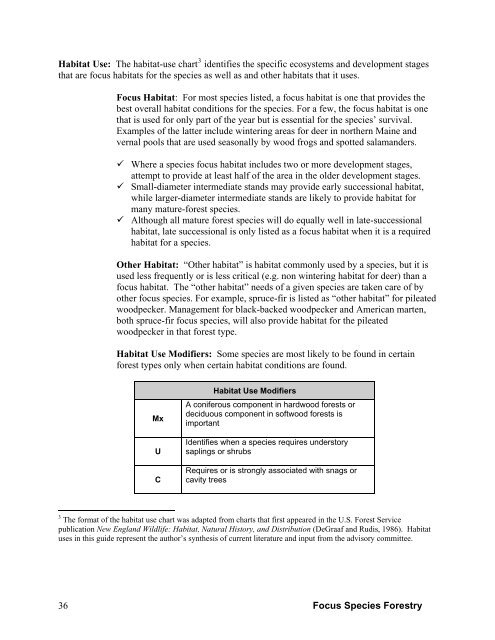
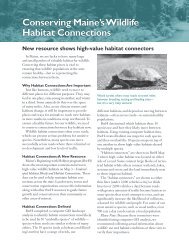
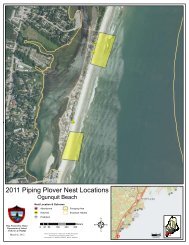
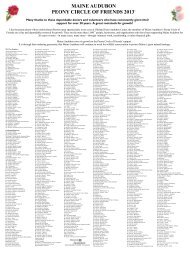
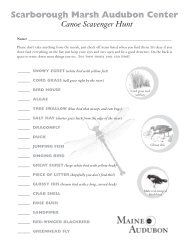

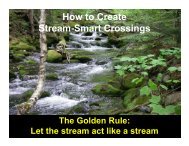
![2012 Loon Count Results [pdf] - Maine Audubon](https://img.yumpu.com/26228732/1/190x245/2012-loon-count-results-pdf-maine-audubon.jpg?quality=85)
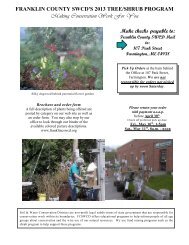
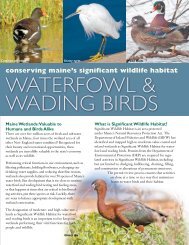
![Lake Fish of Maine (DIFW list) [pdf] - Maine Audubon](https://img.yumpu.com/23282964/1/190x245/lake-fish-of-maine-difw-list-pdf-maine-audubon.jpg?quality=85)
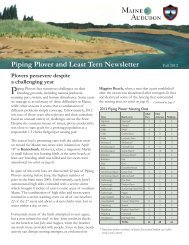

![The Maine Audubon Peony Circle of Friends 2012 [pdf]](https://img.yumpu.com/22707677/1/190x253/the-maine-audubon-peony-circle-of-friends-2012-pdf.jpg?quality=85)
